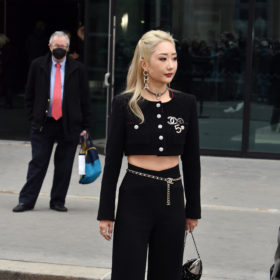
June 10, 2021 at 04:38PM
As lockdowns across Canada begin to lift and our favourite places start to gradually reopen, many of us are likely eagerly awaiting the opportunity to return to our beloved salons. For most of us, that probably means unloading our tresses (and stresses) into our stylist’s chair as we sit back for a much-needed trim. But cutting curly hair is a unique experience that should be handled with care, so we turned to experts for advice on how to prepare for, perfect and care for your next curly cut.
FASHION spoke to Shai Amiel (a.k.a. the curl doctor), whose celebrity clientele includes Tamera Mowry and Kehlani, and Vernon François, celebrity hairstylist (his client roster includes Serena Williams, Lupita Nyong’o and Willow Smith), global consultant for Redken, and global inclusivity and education advisor for Kérastase, for their top curly haircut tips.
How to tell if it’s time to trim your curly hair
ADVERTISEMENT
ADVERTISEMENTKate Spade Autumn/Winter Sale |
Before we dive in, it’s important to learn how to determine if you’re in need of a cut in the first place. “If your ends are appearing thin and wispy, [compared to] your mid-lengths, or if the shape of your original hairstyle is growing out,” you could very well be in need of a snip, says François. If you have kinkier hair, one of the telltale signs you’re in need of a cut is when the ends of your hair begin to tangle. If you have textured hair, you may be hesitant to give up some length, especially if you’ve been blessed with extremely tight curls. Amiel reminds us, however, that you should be trimming your hair every three to four months in order to keep hair healthy. Trimming hair regularly can actually help with length retention and help your hair grow more in the long run. “Snipping those ends on a regular basis will stop them from splitting down the shaft,” says Amiel. This is why sometimes you may be doing everything right but your hair appears to have stopped growing. Often the answer is a simple trim.
Why you should never skip the consultation
Now that you’ve decided you need a trim, the next step is to book a consultation. Both Amiel and François agree that you should have some sort of conversation with your stylist prior to your appointment so that both of you are clear on expectations. This will be an opportunity for your stylist to share with you some of the benefits of cutting more or less hair than you intended, and thus giving you the opportunity to make an informed decision.
ADVERTISEMENT
ADVERTISEMENTSports Direct Free Delivery on All Orders! |
Before you arrive at your appointment, you should have your hair styled in its most natural state, or in the way that you will be wearing it post-cut. “It’s best to wash it the day of or the day before, allowing it to dry in its natural state without manipulating it,” says Amiel. “For best results we don’t recommend styling it with any type of a bun, ponytail, or braid, and if you can, avoid wearing hats, clips, scarves, or heavy oils.”
What to know about appointment day
Once you’ve arrived at your curly cut appointment and are sitting in the stylist’s chair, what can you expect from your stylist? For Amiel, who is responsible for giving Kelhani that coveted pixie cut, he likes to cut hair curl by curl in order to achieve the best results. The beautiful thing about curly hair is that, like a snowflake, no two curls are the same. So in order to give off a somewhat uniform appearance, it’s important to give each curl special attention.
ADVERTISEMENT |
When you begin the process, it may look like the stylist is cutting a lot of hair, but François assures us that there is no general rule when it comes to cutting hair. “The amount of hair that is cut will depend on the rate of hair growth, how long it’s been since you last had a trim, your lifestyle, and if you’re looking to maintain, shorten or extend your overall hair length,” he says.
As for attempting DIY curly cuts? Both celeb stylists are on the same page when they say that it’s not recommended. Amiel says that cutting your curly hair on your own can “lead to an uneven disaster.” Haircuts are “a service that need to be delivered by a professional hairstylist,” says François. Otherwise “it could end up being costly if you have to restyle or if you accidentally create more split ends.”
Curly cuts after-care 101
As for caring for your curly cuts, all roads lead back to your stylist. Amiel recommends documenting the cutting and styling process if you can, and actually using the products that your stylist recommends. He also emphasizes the importance of staying away from heat — meaning no straighteners or blow dryers. In fact, stretching your hair in any capacity should be avoided at all costs. “Let each curl or coil fall and form the ringlet they want without manipulation,” says Amiel. “For best results, don’t even put your hair in a bun or a ponytail until it is completely dry. If you pull your wet or damp hair back while stretching it and forcing it to dry elongated, it’s going to weaken your curl pattern. This is as damaging as using a blow dryer and round brush.”
Missed our last Texture Talk column? Click here.
The post Texture Talk: Two Celeb Stylists Share Everything To Know About Curly Cuts appeared first on FASHION Magazine.
Read More Fashion News
Author Kenisha Alexander | Fashion Magazine
Selected by CWC
ADVERTISEMENT
ADVERTISEMENTUp to 30% off Gift Sets |








